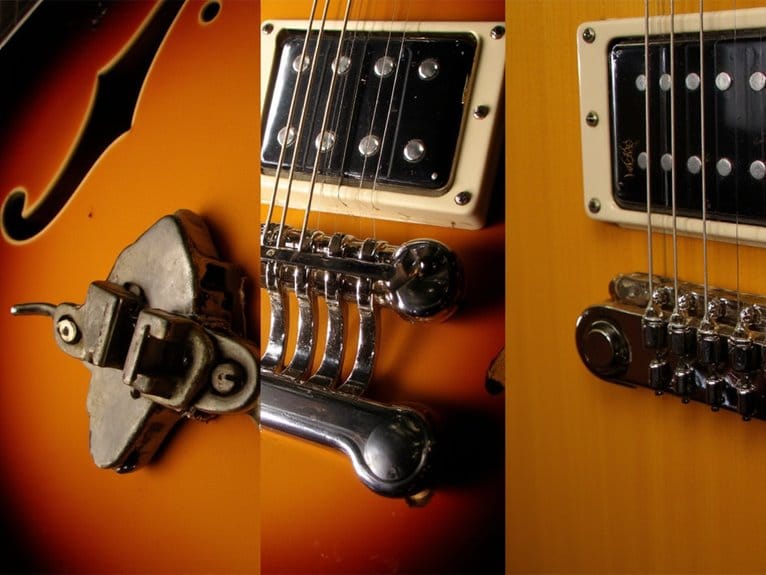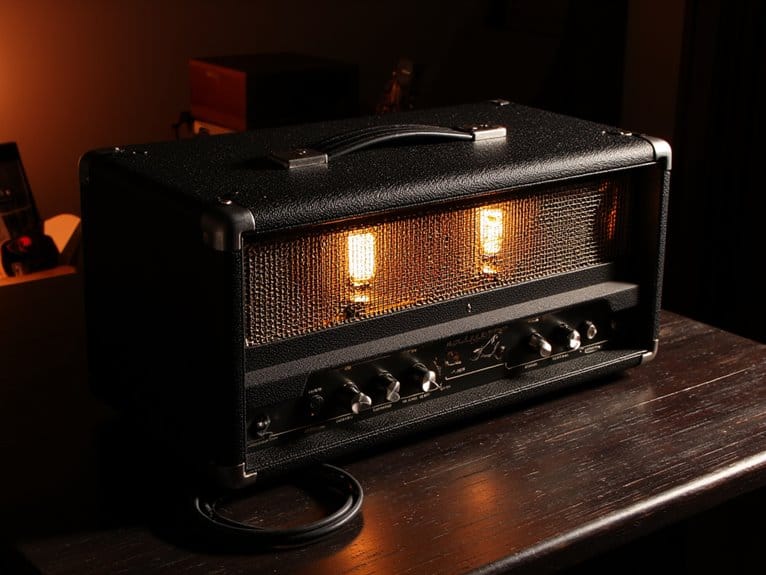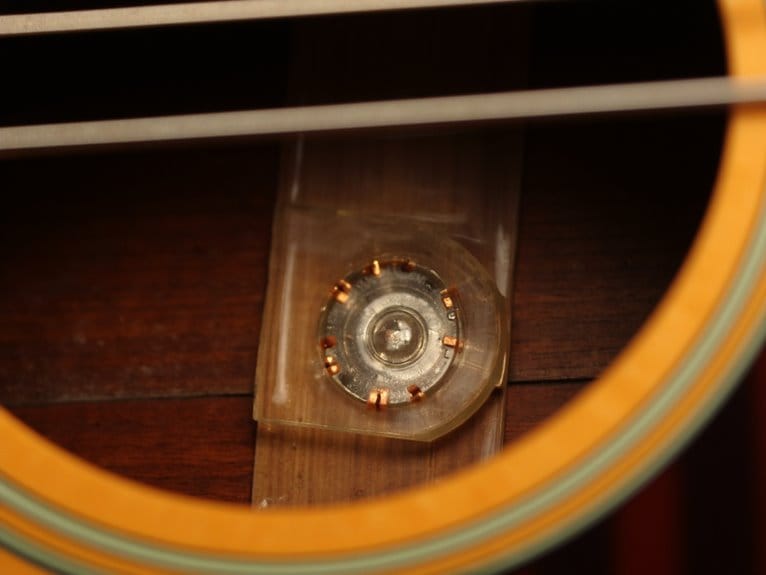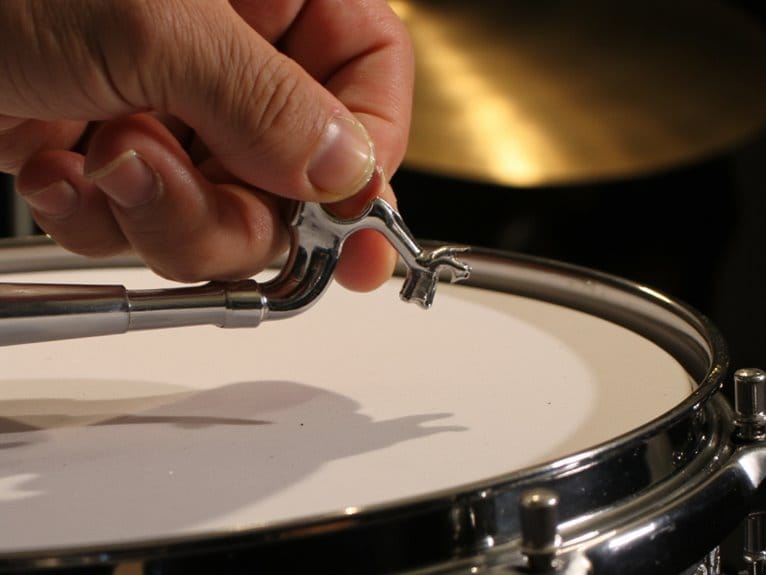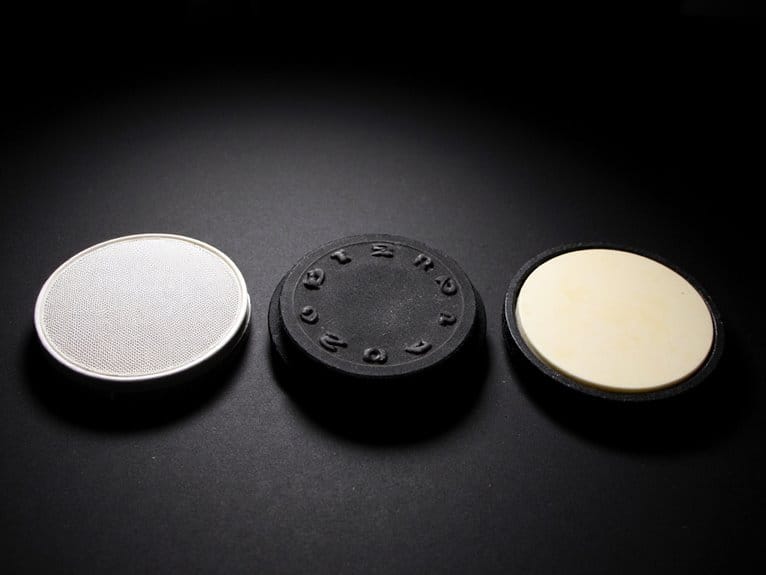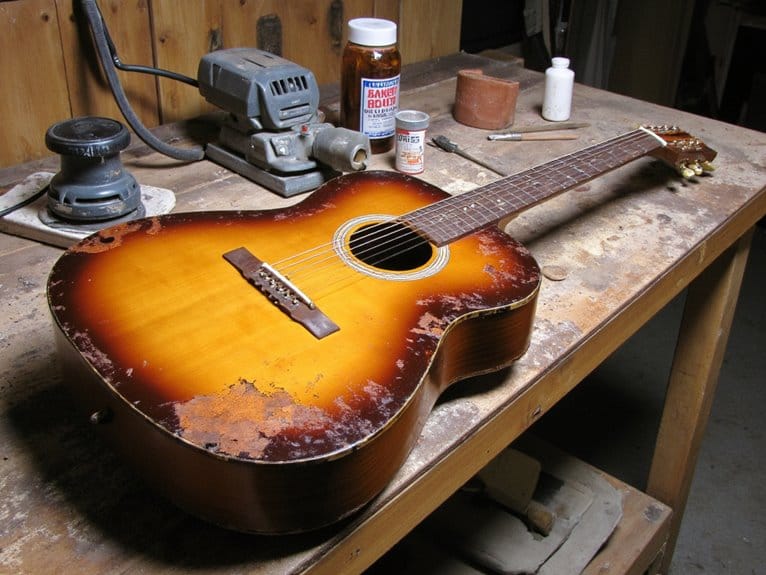Bridge and Tailpiece Setup for Different Playing Styles
Your bridge and tailpiece setup dramatically shapes your guitar’s voice for different playing styles. For rock and metal, you’ll want aluminum components with moderate action height to achieve punchy attack and sustain. Blues players benefit from brass saddles and slightly raised tailpieces that enhance midrange warmth, while jazz musicians need stable positioning to handle heavy flatwound strings. The materials you choose-steel for brightness, brass for warmth, titanium for extended sustain-combine with proper intonation adjustments to reveal your instrument’s full potential.
We are supported by our audience. When you purchase through links on our site, we may earn an affiliate commission, at no extra cost for you. Learn more.
Notable Insights
- Rock playing benefits from aluminum bridge components and moderate height adjustments with 11-52 gauge strings for optimal performance.
- Blues setups require moderate tailpiece height positioning to enhance crucial midrange warmth and tonal character.
- Jazz styles need stable tailpiece positioning and heavier flatwound strings for clean articulation and sustained notes.
- Bridge saddle materials significantly impact tone: steel creates brightness, brass adds warmth, titanium extends sustain length.
- Action height at the 12th fret must balance fretting ease with sustain, requiring individual saddle adjustments.
Bridge and Tailpiece Types: Understanding Your Hardware Options
The foundation of your guitar’s voice lies in two often-overlooked components that work together like a mechanical symphony: the bridge and tailpiece.
Understanding your options starts with recognizing how bridge designs fundamentally shape your instrument’s character, from the precise adjustability of Tune-O-Matic systems to the vintage simplicity of wraparound bridges.
Tailpiece materials and mounting methods create distinct tonal signatures, whether you’re working with Gibson’s traditional stop tailpiece, Nashville-style thumb-wheel adjustments, or Fender’s integrated bridge-tailpiece combinations.
Each design offers specific advantages: Tune-O-Matic provides surgical intonation control, wraparound delivers vintage sustain through fewer moving parts, while trapeze tailpieces on hollow bodies create that warm, jazz-friendly resonance that’s honestly hard to replicate elsewhere.
For Stratocaster-style guitars, tremolo bridge materials make a substantial difference in tone and sustain, with heavy brass blocks delivering richer sonic depth compared to lightweight zinc alloy alternatives.
How Bridge Setup Affects Tone and Sustain
While many guitarists obsess over pickups and amplifiers, I’ve found that bridge setup creates some of the most dramatic differences in how your instrument actually sounds and sustains.
The saddle material you choose-whether steel, brass, or titanium-directly impacts both tonal clarity and sustain length through improved vibration transfer to your guitar’s body.
Material choice in saddles dramatically shapes your guitar’s voice-steel brightens, brass warms, titanium extends sustain through superior energy coupling.
Bridge mass plays an essential role in energy retention, where heavier bridges typically deliver fuller tone and extended sustain.
Here’s what affects your sound most:
- Saddle height and break angle – Controls string pressure and sustain
- Bridge material density – Determines vibration transfer efficiency
- Contact surface area – Influences resonance coupling with body
- Intonation precision – Guarantees ideal energy transfer across strings
Getting your string break angle right maximizes downward pressure while maintaining tuning stability.
Fixed bridges provide enhanced tuning stability compared to floating bridge systems, eliminating tremolo-related issues that can compromise both sustain and overall performance reliability.
Optimizing Your Setup for Rock, Metal, Blues, and Jazz
Once you’ve dialed in your bridge’s fundamental sound characteristics, your playing style becomes the deciding factor in how you’ll want to fine-tune your tailpiece and bridge combination.
For rock tailpiece setups, I recommend aluminum components with moderate height adjustments to handle 11-52 gauge strings while maintaining tuning stability during aggressive picking. Metal choices demand robust wraparound bridges or milled aluminum tailpieces that withstand extreme string tension without compromising intonation during palm muting sessions.
Blues adjustments focus on moderate tailpiece height with metal components that enhance midrange warmth, allowing expressive bending with 10-46 strings. The characteristic steel baseplate in traditional t-style guitars contributes significantly to the twang that defines blues tone by affecting pickup magnetic fields.
Jazz techniques require stable tailpiece positioning that supports heavy flatwounds while providing the down pressure necessary for clean projection and resonance on archtop guitars.
String Action and Intonation Adjustments for Maximum Playability
After establishing your bridge and tailpiece configuration for your preferred playing style, achieving ideal string action becomes the foundation that determines whether your guitar feels effortless under your fingers or fights you at every fret.
I measure action at the 12th fret from string bottom to fret top, ensuring proper tuning first since tension affects height accuracy.
Here’s my systematic approach to action optimization:
- Start with truss rod adjustment – slight neck relief prevents buzzing while maintaining low action
- Adjust bridge saddles individually – accommodate different string gauge requirements per string
- Check intonation iteratively – retune and verify 12th fret harmonics after each height change
- Monitor tuning stability – seasonal neck movement requires periodic readjustment for consistent playability
Lower action eases fretting but risks buzz; higher action improves sustain but demands more finger pressure. New guitars typically require action lowering since manufacturers set high string actions to prevent fret buzz during initial testing and shipping.
Maintenance Tips to Keep Your Bridge and Tailpiece Performance Consistent
Three fundamental maintenance practices separate guitars that perform consistently for decades from those that develop problems within months, and I’ve learned these lessons through countless hours of setup work on instruments ranging from budget models to vintage collectibles.
First, effective tarnish prevention requires wiping bridge and tailpiece surfaces after each session, particularly focusing on high-contact areas where palm-muting occurs.
Consistent wiping of bridge and tailpiece contact points after playing prevents corrosive tarnish buildup that degrades hardware performance.
Second, proper lubrication techniques involve applying small amounts of compatible lubricant to bridge saddles and tailpiece studs, which prevents string binding and reduces breakage risks.
Finally, regular structural inspections catch cracks, loose bolts, or alignment issues before they compromise your instrument’s performance, ensuring that your hardware maintains ideal vibration transfer and tuning stability.
On a final note
You’ve now got the foundation to dial in your bridge and tailpiece setup for whatever style moves you. Whether you’re chasing that crisp jazz articulation, sustaining metal riffs, or bending blues phrases, the right adjustments make all the difference. I’ve found that regular maintenance keeps everything performing consistently, and honestly, a well-setup guitar just feels better under your fingers. Take your time with these adjustments-you’ll hear the difference.

